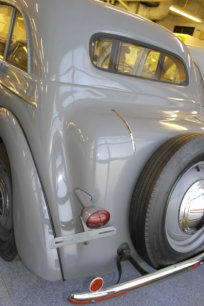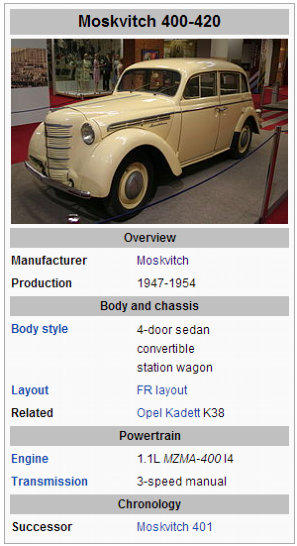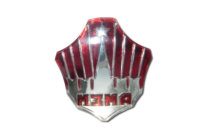



Stalins choise for the first mass produced car in Soviet Union

Moskvich 401 - 55
The Moskvitch 400-420 was a car from Soviet
manufacturer Moskvitch introduced in 1947.
Between 1940 and 1941, the Russians had independently made 500 units of the KIM 10-50, a loose copy of the similarly sized four-door Ford Prefect, but national priorities changed with the German invasion of Russia in Summer 1941, and the production of the Ford inspired car was not resumed after the war. It was Joseph Stalin who personally chose in June 1945 a four-door Kadett to become a first mass-produced popular Soviet car, so plans and tooling of a four-door version had to be reconstructed with help of German engineers, who worked upon them in a Soviet occupation zone. Development began in 1944, following a prewar plan to produce a domestically-built car able to be used and maintained by citizens living outside major cities. The KIM factory was selected to build the car, with the prewar KIM 10-52 (not built due to the Second World War) as a basis, with production approved in May 1945 and prototypes intended to be ready in December; by the end of May, however, these plans had faltered. At war's end, the Soviet Union deemed the plans and tooling for the 1939 Opel Kadett K38 as part of the war reparations package, since the tooling in the Rüsselsheim factory was largely intact; residents dismantling the Kadett production tooling and loaded fifty-six freight cars, bound for Moscow and the newly-built "Stalin Factory" (ZIS). However, according to recent Russian sources, the Kadett plans and tooling were in fact not captured from the factory, because they did not survive there (and what survived was appropriate for producing a two-door model). In any event, after KIM was renamed MZMA (Moscow Zavod Malolitratsjnij Avtomobilij, Moscow Factory for Making Small Cars) in August 1945, the new car was ready for production before the end of 1946 (somewhat behind the planned June deadline): the first 400-420 was built 9 December, "400" meant a type of engine and "420" the (saloon) body style. With unitized construction, independent front suspension, three-speed manual transmission. and hydraulic brakes, it was powered by a 23 hp (17 kW; 23 PS) 1,074 cc (65.5 cu in) inline four (with a compression ratio of 5.6:1). Acceleration 0–50 mph (0–80 km/h) took 55 seconds, and achieved 9 L/100 km (31 mpg-imp; 26 mpg-US) (the best of any Soviet car at that time). With a wheelbase of 2,340 mm (92 in)) and ground clearance of 200 mm (7.9 in)), it measured 3,855 mm (151.8 in) long overall 1,400 mm (55 in) wide, 1,550 mm (61 in) tall. Approved for mass production by the Soviet government on 28 April 1947, 1,501 were built the first year, with 4,808 for 1948 and 19,906 in 1949, the same year a mesh oil filter was introduced. In 1951, synchromesh was introduced on the top two gears, and the gear lever relocated to the steering column. In 1948, a prototype woodie wagon, the 400-422, with an 800 kg (1,800 lb) payload, was built, but never entered production. Neither did the similar 400-421 estate or pickoupe. The 400-420A cabriolet debuted in 1949. Most of the Opel tooling removed to Russia was for the two-door Kadett model, and the Russians converted this into a 4-door configuration that visually was near identical to the original Kadett 4-door. Although Opel was U.S. property, GM did not recover control of the factory until 1948 and were therefore unable to contest the transfer. The 400 went on sale in Belgium in October 1950, making it a very early Soviet automotive export product, priced at ₤349: below the Ford Prefect and Anglia, and well below the Morris Minor. Motor praised its engine's quietness, the caliber of its finish, and the quality of the ride. The 100,000th Moskvich was built in October 1952. Several prototypes were also built. In 1949, proposal for an improved 26 hp (19 kW; 26 PS) 401E- 424E and a 33 hp (25 kW; 33 PS) 403E-424E saw only six examples built. Following this, in 1951, the factory produced the 403-424A coupé with a 35 hp (26 kW; 35 PS) four. The "stunning" 404 Sport of 1954 used a new 58 hp (43 kW; 59 PS) overhead valve hemi engine.Moskvitch 401
The Moskvitch 401 (full designation: Moskvitch 401-420) was introduced in 1954, an improved variant of the 400-420. It weighs 885 kg (1,951 lb). and was powered by an 1,074 cc (65.5 cu in) sidevalve inline four engine, uprated from 23 hp (17 kW; 23 PS) to 26 hp (19 kW; 26 PS), thanks to a higher compression ratio, of 6.2:1, and improved intake and exhaust manifolds. Other changes included a new starter motor, dynamo, wheel bearings, and handbrake. Both models were externally identical. It had a top speed of 90 km/h (56 mph). The 400-422 sedan delivery variant was renumbered 401-422 (Its production continued until December 1956.) There was also a pickup version, the 401-420B. Some of the production was exported, among other countries to East Germany and Norway. Production ended in 1956, when the design was heavily outdated. Private users in Norway at the time needed a license to buy a new imported car. This did not apply to Russian cars that as a "friendly gesture" were supplied in exchange for fish. Production of the saloon ended 20 April 1956, when it was replaced by Moskvitch 402. 247,439 had been built, counting both the 400 and 401.
1955
Engine 1007 cc 4 cylinders Power 26 HP Lenght/width 3,86 m/1,37 m Weight 845 kg The collection has two 401 models, from 1954 and 1955. The 1954 model is for sale.


Photos mainly by Matti Kreivilä. Historical facts and technical details of the vehicles provided by Wikipedia. Movies YouTube.



- Decade of 60's
- Austin 850 Pickup - 1962
- Chaika Tshaika 13 GAZ - 1962
- Citroen 2CV - 1961
- DKW Junior - 1961
- Fiat 1100 - 1963
- Ford Taunus 12M - 1961
- GLAS 1204 - 1963
- MG 1100 - 1964
- Moskvich 407 - 1961
- Nagetusch caravan - 1961
- NSU Printz 4 - 1961
- Opel Kadett A - 1964
- Panhard PL17 - 1961
- Peugeot 404 - 1962
- Renault Dauphine - 1965
- Simca Aronde P60 - 1960
- Simca 1000 - 1966














